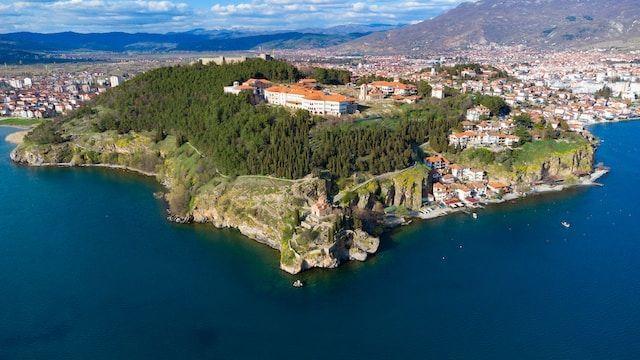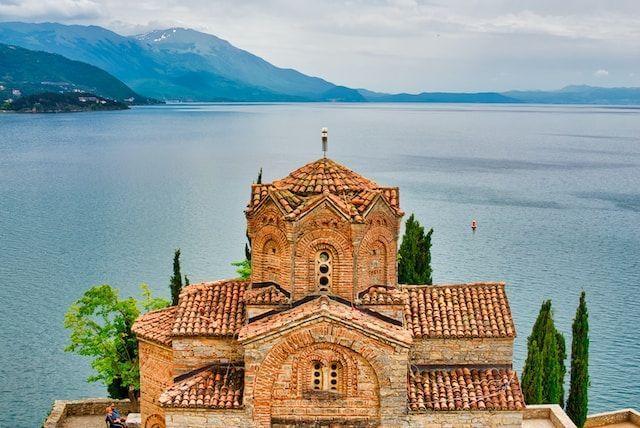Ohrid Travel Guide: Notes for Traveling to Ohrid
Traveling to Ohrid means immersing yourself in a world of natural beauty and enchanting landscapes. Located in North Macedonia, this small city will captivate you with its famous turquoise lake and picturesque surroundings in the Balkan region. Our Ohrid travel guide is packed with tips and recommendations so you can discover all the treasures that this place has to offer.
General Information about Ohrid
Ohrid is a town in North Macedonia. It is one of the oldest cities in Europe and has been declared a UNESCO World Heritage Site in recognition of its cultural and historical importance.
The city of Ohrid has a rich history, dating back to Roman and Byzantine times. The city has been an important religious and cultural center and boasts numerous historical and religious sites.
In addition to its cultural heritage, Ohrid is also known for its beautiful beaches and Lake Ohrid, which is one of the oldest and deepest lakes in Europe. The lake is a popular tourist destination and offers a wide range of water activities.
The city of Ohrid has a population of about 40,000 inhabitants and is one of the main tourist destinations in North Macedonia.
Geography of Ohrid
If you are wondering where Ohrid is located, you should know that is a city located in the southwest of North Macedonia, on the shores of Lake Ohrid, which is located on the border with Albania. The city is surrounded by the Galicica mountains and the Struga Plain.
Lake Ohrid is one of the oldest and deepest lakes in Europe, with a maximum depth of 296 meters. The lake is known for its crystal-clear water and unique biodiversity and is home to many endemic species.
The Galicica Mountains separate Lake Ohrid from Lake Prespa, which lies to the west of Ohrid. The mountain is a popular destination for hikers and nature lovers.
The Struga Plain is located north of Ohrid and is a fertile lowland region. The region is known for its production of apples and other fruits.
Map of Ohrid on Google Maps
What to Do in Ohrid: Activities
Ohrid offers a wide variety of activities for tourists, from water activities to cultural visits and outdoor sports. These are some of the most popular activities.
A boat ride on Lake Ohrid is one of the best ways to explore the lake, tourists can take a boat ride from the Ohrid port and enjoy the spectacular views of the lake and surrounding mountains.
In addition, you can enjoy water activities in Ohrid, as the city has numerous beaches along the lake, where tourists can sunbathe, swim and enjoy the views. You can also consider fishing, windsurfing, water skiing, swimming, and diving. It is possible to rent equipment and enjoy the crystal clear waters of the lake.
You can also visit the historical sites of Ohrid, as the city has many historically and culturally significant attractions to visit, such as the Ancient Theatre, Samuel's Fortress, and the Church of St. John in Kaneo.
Finally, the Ohrid region has many hiking and biking trails, as well as opportunities for outdoor sports such as paragliding and hang gliding. You can explore the mountains and enjoy stunning views of the lake and the surrounding region.

Photo of lake, mountain, and the city of Ohrid
Photo by Slavcho Malezanov on Unsplash
What to See in Ohrid: Main Attractions
Ohrid is a culturally and historically rich city and has numerous sites of interest for tourists and visitors. Below, we show you some of the most outstanding places.
Ohrid Old Town is the historic center of the city and features numerous narrow cobblestone streets, old houses, and historic buildings.
The Church of St. Sophia is one of the oldest churches in the city, built in the 11th century in Byzantine style and noted for its frescoes and architecture. While the church of St. John in Kaneo is located on a cliff overlooking Lake Ohrid.
The monastery of St. Naum is an Orthodox monastery located on the shore of Lake Ohrid, about 30 kilometers from the city, and is famous for its frescoes and natural beauty.
The Ancient Theater of Ohrid is a Roman theater from the 2nd century BC, located in the center of the city, and is one of the few Roman theaters still in use in Europe. The Ohrid Fortress is located on a hill above the city. It offers breathtaking views of Lake Ohrid and the city.
The Ohrid Museum is dedicated to the history and culture of the city and the region.
The city also has numerous beaches along the shore of Lake Ohrid, which are ideal for swimming, windsurfing, and other water activities.
Beaches of Ohrid
As we mentioned before, Ohrid is a town located on the shores of Lake Ohrid, one of the oldest and deepest lakes in Europe. The lake has numerous sandy and pebble beaches along its shores and is a popular destination for tourists looking to enjoy the sun and crystal-clear water.
Gradiste Beach is located south of Ohrid and is one of the most popular beaches in the region, it has a long stretch of sand and is ideal for sunbathing and enjoying the views of the lake.
Kaneo Beach is in the center of Ohrid, near the church of St. John of Kaneo. It is a small, picturesque beach with crystal-clear waters and a spectacular view of the lake.
Labino Beach is located east of Ohrid and is a pebble beach with a spectacular view of the lake, it has a long stretch of beach and is popular with tourists and locals.
St. Stefan Beach is located north of Ohrid, near the village of Elshani. It is a quiet and picturesque beach with crystal clear waters and a relaxed atmosphere.

Photo of a monastery in front of a lake and mountains
Photo by Gorjan Ivanovski on Unsplash
Ohrid Festivals
Ohrid is known for its festivals and cultural events, which attract visitors from all over the world. Some of the most important and popular festivals are:
The Ohrid Summer Festival is one of the largest festivals in the city and is held every year in July and August. It includes a wide variety of events, such as classical and modern music concerts, plays, dances, and an open-air cinema.
The Ohridski Trubaduri is a pop music festival held every year in August. It attracts many young people from all over North Macedonia and the Balkans.
St. Clement's Day is a religious and cultural festival held on July 23 in honor of St. Clement of Ohrid, the patron saint of the city. It includes religious processions, music, dances, and traditional food.
The International Folklore Festival is a festival of folk dance and music held every year in September. Folk groups from all over the world participate and offer a unique experience for visitors.
The Ohrid Film Festival is held every year in September. It includes screenings of films and documentaries from around the world, as well as panel discussions and workshops on the film industry.
Ohrid’s Gastronomy
Ohrid is rich in flavors and varieties and has a strong influence on Balkan and Mediterranean cuisine. We recommend some of its best dishes:
Lake Ohrid fish is fresh and delicious, especially trout, carp, and perch. They are prepared in various ways, from grilled to stews and soups.
Tavche Gravche is one of Macedonia's most traditional dishes, made from white beans cooked in a clay oven with tomatoes, peppers, onions, and spices. Ajvar consists of a paste made with roasted peppers, garlic, and olive oil, it is used as an accompaniment to many dishes and as a sauce for bread.
Kebapi is skewers of minced meat (usually pork or lamb) served with flatbread, onions, and peppers. While turlitava is a stew made with a mixture of vegetables (zucchini, eggplant, tomato, bell pepper), minced meat, and spices.
Rakija is a fruit brandy produced in Macedonia and is very popular in the region and is made from a variety of fruits, such as plum, grape, and peach.
The Ohrid region is known for its high-quality wines, especially the white wine made from the Smederevka grape.
How to Get to Ohrid
If you are wondering how to get to Ohrid, here are some options that you should know.
The first option is to arrive in Ohrid by plane, since the city has the Ohrid International Airport, also known as Ohrid Saint Paul Apostle Airport, which is located about 10 kilometers north of the center.
The second option is the bus. You will find regular bus connections from the main cities in North Macedonia, such as Skopje, Bitola, and Prilep.
Finally, by car, because you can reach Ohrid through the E65 highway, which connects the city with Skopje and the border with Albania.
Getting around Ohrid: Transportation
If you are thinking about how to get around Ohrid, you should know that this is a small and compact city, so it is easy to get around on foot or by bicycle, but you can also get around by bus as Ohrid has a public transportation system that connects the city center with other surrounding areas.
In addition, there are many cabs available, and they are a good option for tourists who need to get around quickly and comfortably.
Tourists who want to explore Ohrid's surroundings can choose to rent a car. There are several car rental companies available in the city, and the prices are quite reasonable.
Travelers can also opt to take a boat to explore Lake Ohrid.
Get to Know Ohrid Today
Ohrid is a popular destination for nature, history, and culture lovers, as well as for those looking for a relaxing beach vacation.
Thanks to its proximity to other important and cultural sites such as Greece, travelers choose to combine their excursions to Ohrid with these.
Would you like to tour one of the oldest cities in Europe? Would you like to save time when visiting tourist attractions? Greca offers you one-day tours of the most fascinating places in the city. Don't wait any longer and save your precious time with our excursions to Ohrid!
More Travel Guides!
If you were interested in our Ohrid travel guide and want to continue learning about this and other wonderful destinations, we invite you to take a look at our travel guides section, and plan your next adventure with Greca!